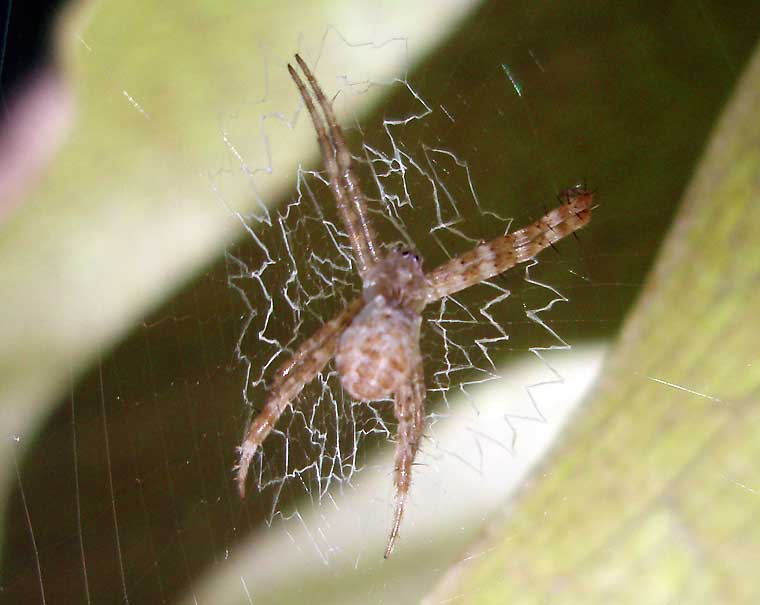A common medium-to-large orb weaver found in eastern Australia in rainforest margins, open forest, heathland, houses and gardens. Zig-zag ribbons of bluish-white silk form a full or partial cross (stabilimentum) through the centre of the orb web. This cross gives the spider Its common name. Females have a silvery carapace and a silver, yellow, red and black banded upper abdomen with two longitudinal yellow stripes below. At rest, legs are held in pairs. The mostly brown coloured males are much smaller. There is some variation in the colour of the males. Prey includes flies, moths, butterflies, bugs and bees. Responds to disturbance by dropping from the web or shaking it vigorously. Named by Friedrich Karsch in 1878 from the Greek Argiope, a nymph. The species name is in honour of the German arachnologist Keyserling. ♀ 16mm ♂ 5mm.
- Adult female in web with stabilimentum
- Female from Bribie Island with partial stabilimentum
- Adult female in sunlight
- Adult female
- Adult female (undersides)
- Adult female on web
- Adult female on foliage
- Juvenile female just starting to colour up
- Male from above, Strathpine, GJA5704
- Adult male from above
- Adult male from front, showing modified palps
- Adult male from side showing palps
- Male adult Flinders Beach, North Stradbroke Island
- Male palps Flinders Beach, North Stradbroke Island
- Male palps Flinders Beach, North Stradbroke Island
- Penultimate male, bright yellow abdomen
- Penultimate male, facing, underneath
- Penultimate male, facing, eyes and palps
- Juvenile male side view
- Juvenile male from above
- Sub-adult male, side on
- Sub-adult male from above
- Sub-adult male face on
- Very small juvenile female body length 2mm from above
- Very small juvenile female body length 2mm from below
- Juvenile female with first stage stabilimentum
Adult female in web with stabilimentum

Female from Bribie Island with partial stabilimentum

Adult female in sunlight
This photograph of a particularly colourful St Andrews Cross was taken in a garden in Riaweena Street, The Gap, Brisbane.

Adult female

Adult female (undersides)

Adult female on web

Adult female on foliage

Juvenile female just starting to colour up

Male from above, Strathpine, GJA5704

Adult male from above
Males are much smaller and with sombre colours, mostly dark brown, sometimes reddish, sometimes yellow. The shape of the cephalothorax is much the same as the female's, but the abdomen is smaller and roughly triangular. The habit of pairing the legs and the white "armbands" on the forelegs are shared by both the male and the female.

Adult male from front, showing modified palps
The silvery hair on the cephalothorax isn't catching the light in this photo, making the cephalothorax look plain, smooth brown. The duller colours of males no doubt allow it to camouflage more easily.

Adult male from side showing palps

Male adult Flinders Beach, North Stradbroke Island

Male palps Flinders Beach, North Stradbroke Island

Male palps Flinders Beach, North Stradbroke Island

Penultimate male, bright yellow abdomen

Penultimate male, facing, underneath

Penultimate male, facing, eyes and palps

Juvenile male side view
This spider 3.6mm body length was in the vicinity of some young female Argiope keyserlingi, and though it hasn't gained the adult shape and colouring probably is the same species.

Juvenile male from above

Sub-adult male, side on
Not entirely having achieved the adult shape and colouration this sub adult male body length about 6mm is closer to adult than the smaller specimen above. It appears that the abdomen becomes relatively smaller and the colours darken and simplify. The sub adults can be larger than the adults.

Sub-adult male from above

Sub-adult male face on

Very small juvenile female body length 2mm from above
A small juvenile, pale, suggesting it has just moulted. It has constructed a small, rudimentary web.

Very small juvenile female body length 2mm from below
No obvious epigynum on this female, suggesting it is not mature, otherwise all indications are that it is a very small juvenile of Argiope keyserlingi.

Juvenile female with first stage stabilimentum
The shape of the stabilimentum changes with the age of the spider. First it starts with a circular white web in the center. Later it changes to a cross and when the spider is full-grown only a small zig-zag remains.


